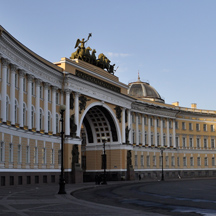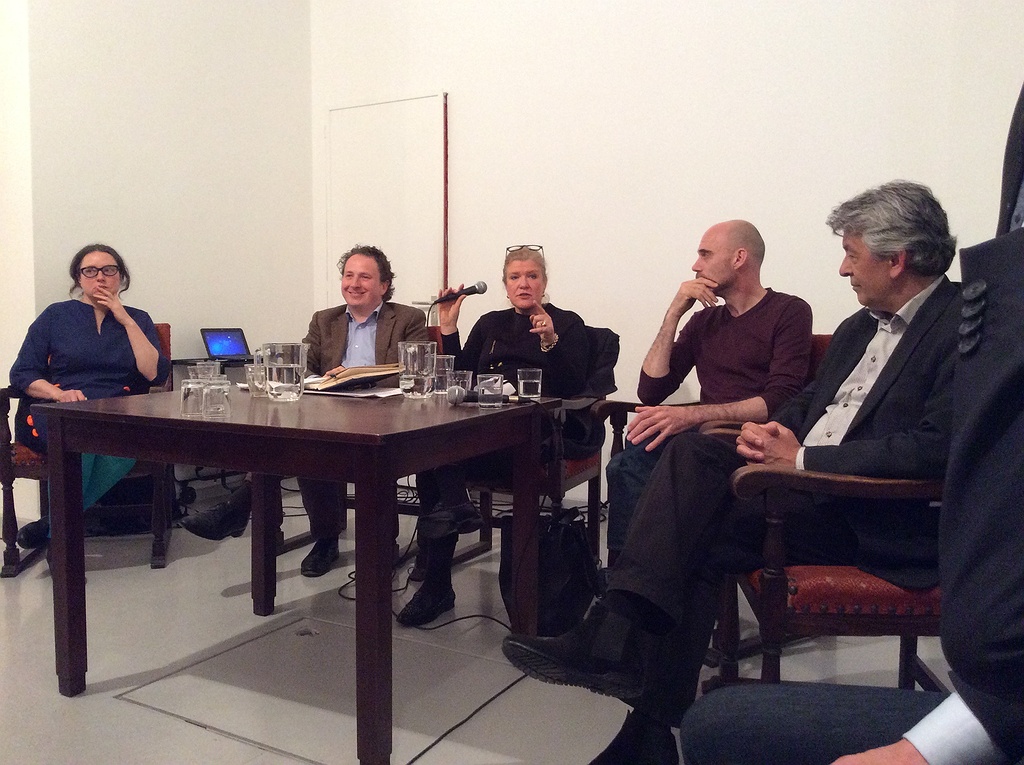
Европейская биеннале современного искусства
28 Июня 31 Октября 2014
Санкт-Петербург, Россия Государственный Эрмитаж
Manifesta debate in Amsterdam: No Boycott
размещено: 21 мая 2014 г. 16:11:06

During the Manifesta debate organised by AICA Netherlands on Thursday April 24 in Amsterdam at Castrum Peregrini, all panel members agreed on one thing at least: MANIFESTA 10 must go on. A boycott would hurt everybody involved and will not contribute anything to the promotion of human rights in Russia.
Author: Machteld Leij
When AICA Netherlands’ board wrote a letter last November to Manifesta’s director Hedwig Fijen appealing her to reconsider St. Petersburg as the venue for MANIFESTA 10 and asking her to explain how the consequences of criminalising homosexuality and the alleged promotion of homosexual propaganda among minors can be dealt with, Russia’s invasion of Crimea was not an issue yet. The letter also expressed their worries that Manifesta will be abused as a vehicle for propaganda. During the debate, led by art critic Edo Dijksterhuis, a panel consisting of MANIFESTA director Hedwig Fijen, Russian artist Gluklya, Dutch human rights ambassador Lionel Veer, Russia expert and Manifesta advisory board member Sjeng Scheijen and COC’s Koen van Dijk stated their views. Can a MANIFESTA exist in an environment of censorship and possibly self-censorship? How critical can art be in St. Petersburg when any comment on the escalating violence against homosexuals can be suppressed? The criminalisation of homosexuality makes freedom of expression impossible and is unacceptable, poses AICA Netherlands chairman Robert-Jan Muller.
During the debate answers were worded carefully, and nuances and backgrounds were outlined. A boycott? Nobody wants that, the panel nor the audience. There are, however, plenty of comments, and artists in the audience refer to -previous- censorship.
Koen van Dijk, director of COC, says that members of the LGBT community do not wish to be ignored. When the debate was going on about whether or not to boycott the Olympic Games in Sochi, Van Dijk states, members of the Russian LGBT community made an appeal not to abandon them, but to make a point of coming to Sochi and confront the Russian government with respect to these developments.
Sjeng Scheijen, historian, Russia expert and member of the MANIFESTA advisory board, sketches the recent developments in Russian society. Since Poetin was re-elected he sees a development in which civil rights are being restricted, all on the pretext that the majority needs to be protected against viewpoints they find disagreeable. The situation for homosexuals in Russia was bad to begin with, but has worsened considerably. Scheijen talks of progressive circles which act as pockets of broadmindedness, of how certain newspapers and magazines still have a modicum of freedom, albeit because the authorities do not perceive them as threats yet.
Hedwig Fijen, who has been MANIFESTA's director for twenty years, briefly outlines its history. The travelling biennial has existed for twenty years now and was established, among other things, to investigate the cultural landscape in Europe after the fall of the Berlin Wall. Its venues are often politically or economically charged. The biennial does not only want to address the art world, but particularly wants to generate a wider audience, to familiarize people with the opportunities art can offer. It does not accept censorship or self-censorship. In answer to a question from the audience whether there is a limit, a moment in which Manifesta will be cancelled, Hedwig Fijen indicates there are alternative plans, but she does not go into detail.
Fijen, the director of the State Hermitage Museum Mikhail Piotrovsky and Kasper Koenig, MANIFESTA's curator, have also agreed upon a principle of solidarity: if any artist’s work is made impossible, most other artists will withdraw. She outlines the existing plans: apart from the exhibition at the Hermitage there is an extensive programme of additional activities, also in public spaces. There is a summer school, which will involve school children and the general public. The art that will be on display at the Hermitage seems safe to her; the Hermitage is not the Kremlin, its director Mikhail Piotrovsky has stated. Perhaps this assurance is somewhat tsarist, Fijen says, but Piotrovsky guarantees artistic freedom at the Hermitage and says not to accept censorship. Incidentally, it turns out that the worries expressed in AICA’s letter that artists might not be granted entry to Russia because of their sexual preference was unfounded, according to Fijen. The artists have started work and nobody has been denied entry. She does, however, have other concerns: the art projects outside the safe walls of the Hermitage are more likely to arouse protests from the more conservative part of the population. There is a chance that MANIFESTA, under pressure of such protests, will be forced to close its doors early.
From the audience Russian artist Julia winter describes the situation surrounding the exhibition Sluizen. Change of Poles, which was part of the fifth Moscow Biennial in 2013. The organising committee at the exhibition venue wanted to interfere with Erik van Lieshout’s art project by removing elements they did not like. Curator Maarten Bertheux refused to let this happen. In the end the exhibition took place, but it was decided to only admit people over 18.
Yuri Veerman, of Platform Beeldende Kunst (Platform Visual Arts) wonders why AICA has a problem in the first place, when artists in Russia in general do not want a boycott and MANIFESTA claims to want to create critical space. AICA chairman Muller again expresses his worries that artists or art works addressing love between members of the same sex will be refused. And, he adds, journalists in Russia probably will not write about this. Curator Irene de Craen makes an appeal to go and record what happens. AICA-member and researcher Antje von Graevenitz stresses AICA has traditionally visited areas plagued by complex political circumstances with the explicit purpose to call attention to artists and minorities living in those areas.
A member of the audience wonders how MANIFESTA can be critical in view of the biennial’s intended comprehensiveness: is it even possible to take a stand? Hedwig Fijen stresses that the point is to reach a wide audience in St. Petersburg in order to initiate a critical debate, not just the professional platform. She reads out a statement by participating artist Thomas Hirschhorn, who appeals to MANIFESTA not to let itself be put on the defensive: “A boycott has a price you have to be willing to pay. If you do not, the boycott is opportunistic and has failed. It’s not up to you, MANIFESTA, to justify why you are not boycotting. It’s up to those to explain why they do it and how they do it.” Fijen suggests that AICA Netherlands contact AICA’s Russian department in order to exchange ideas.
The debate is concluded by showing a clip of the performance Trilogy, (2003) at St. Petersburg. A battalion of soldiers marches through town holding flimsy white dresses. According to artist Gluklya an event like this would not be tolerated in Russia today.
So although MANIFESTA itself stresses the fact that censorship does not play any role, there is no question that the venue and the circumstances in Russia are charged. As the Russian presence in Ukraine becomes more menacing every day en snippets of news of journalists being imprisoned reach us, it is by no means certain MANIFESTA can take place without let or hindrance. It is, however, exactly in such areas of tension that art can make a difference to all who crave relief in the increasingly conservative and aggressive Russian society. The complexity of this subject begs debate, the exchange of ideas. Not just right now, but hopefully also in St. Petersburg itself, with its citizens, with critics and with artists.
(Translation: Maaike van der Rijst)






